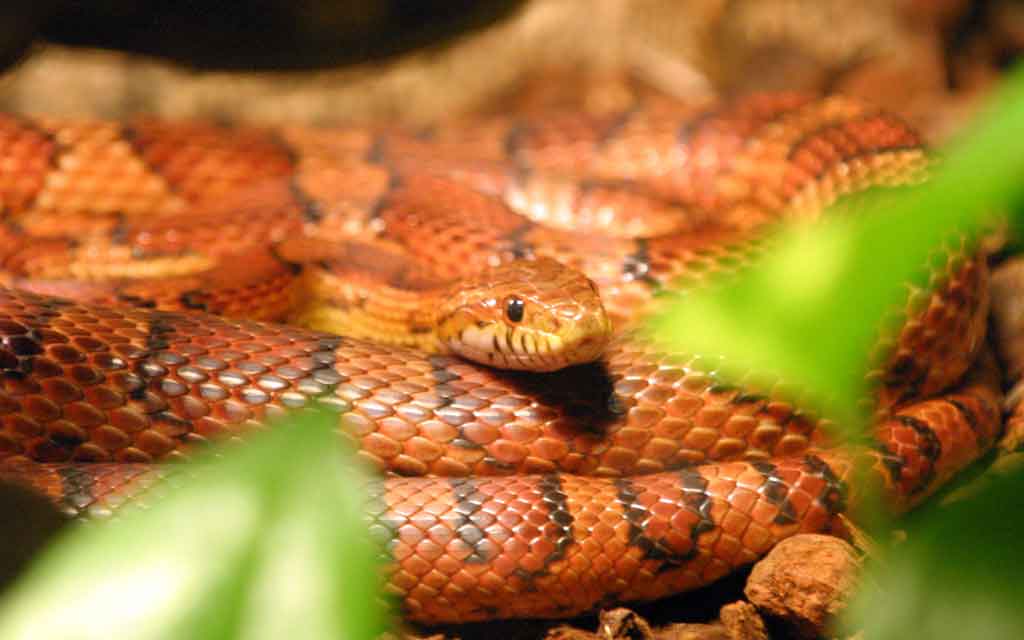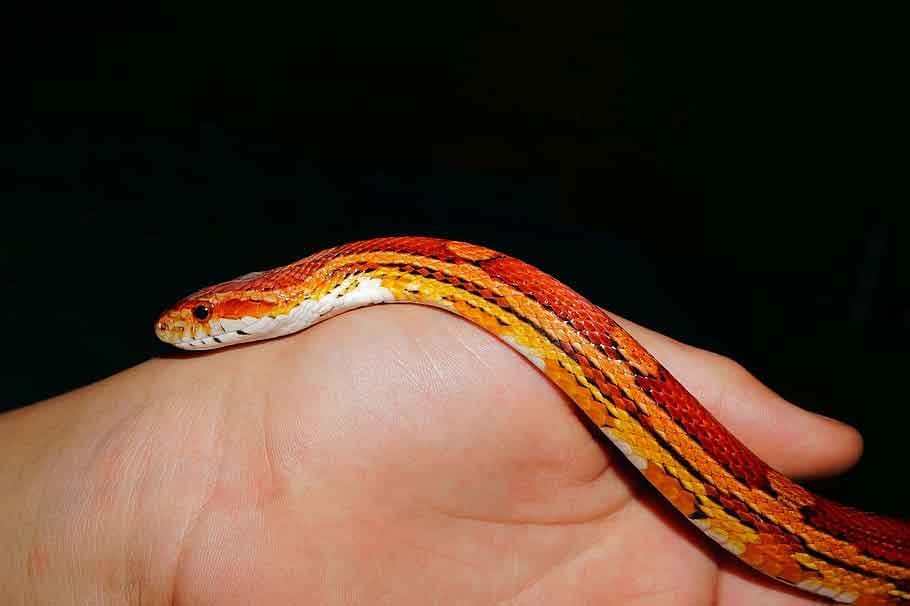
Content |
|---|
Origin / Distribution
The Corn snake (Pantherophis guttatus) can be found in the eastern United States, from southern New Jersey to south, passing through Florida, to western Louisiana and parts of Kentucky. But, the Corn snake is most abundant in Florida and the southeastern United States.
Characteristics / Appearance
The Corn snake has a beautiful pattern of brown to red spots on a gray background, brown to orange-red. The belly of the corn snake is white with steel-blue to black spots. There is a V-shaped pattern on the head. The rump is thin and the head small compared to the body, with a round pupil and only slightly separated from the body.
Habitat
The Corn snake can be found in groves, rocky slopes, Meadows, Plots, barns and abandoned buildings.
Behavior

The Corn snake is mainly nocturnal, but usually active in the early afternoon. They easily climb trees and enter abandoned buildings in search of prey. But, they are very stealthy and spend most of their time underground prowling the burrows of rodents.. They also usually hide during the day under loose bark and under logs., rocks and other debris. Not much is known about the reproductive behavior of the Corn snake.
Reproduction
The breeding season of the Corn snake goes from March to May. Snakes are oviparous and deposit a clutch of 10 to 30 eggs between the end of May and July. Eggs are laid on rotten stumps, piles of decaying vegetation or other similar places where there is enough heat and moisture to incubate them. Eggs are not cared for by adult snakes. Once put, the gestation period of the eggs is 60 to 65 days at approximately 28º. Eggs hatch sometime between July and September. The pups measure between 25 and 38 cm long and mature in 18-36 months.
Food
The Corn snake does not usually feed every day. Usually, are fed every few days, More or less. The young tend to feed on lizards and tree frogs, while adults feed on larger prey, like mice, Rats, birds and bats. They are constrictors, which means they use their coils to choke their food before eating it.. First of all, the Corn snake bites its prey to grab it firmly and, then, quickly envelops the victim with one or more spirals of their body. The snake squeezes hard until it suffocates the prey. Then he swallows the food whole., usually headfirst. But, the Corn snake swallowing small live prey.
Threats to the species
State of conservation ⓘ |
||
|---|---|---|
 Minor Concern ⓘ
(UICN)ⓘ
Minor Concern ⓘ
(UICN)ⓘ
| ||
The Corn snake is often confused with the Copperheads and sometimes she is killed for it. It also, due to his docile temperament, are usually kept as pets. Sometimes they are caught in the wild to sell as pets.. But, there are many snake breeders, so wild capture does not pose a serious threat to this species.
The Corn snake is not an endangered species. But, are listed by the state of Florida as a Species of Special Concern because they face habitat loss and destruction in the lower Florida Keys.
The "Corn snake" in captivity
The Corn snake is the secret queen among terrarium animals. For many years they have been among the most popular and well-known snakes for the terrarium. The reasons are multiple. May be due to attractiveness, the tranquility or ease of maintenance of reptiles. If you are thinking of acquiring a snake, the Corn snake it's a good option. These exotics are ideal for the first steps in the exciting world of terraristics.
The terrarium
The Corn snake is the ideal cohabitant. They are visually appealing, interesting to see, calm, cozy and only demand little from their surroundings. A pet dream! Thus, it is not surprising that more and more terrarium aficionados are acquiring a Corn snake. Beginners, in particular, benefit from the exotic easy care.
As the animal should not roam freely on the floor, you, as owner, you need a terrarium. This must have minimum dimensions of 100 x 50 x 70 cm for the benefit of the animal. But, this information is not set in stone. Depends on the size and number of reptiles. Large animals or a group of corn snakes will require, of course, a larger terrarium.
Behavior in terrarium
The Corn snake is twilight and nocturnal. At night they usually roam the terrarium for hours in search of prey. In spring, which is also the mating season, are also active during the day. If animals are well kept, are already sexually mature by the age of two or three. The Corn snake can live on 12 to 15 years. The record is 25 years!
Terrarium interior design
The interior design of the terrarium should reflect the natural habitat of the Corn snake (Pantherophis guttatus). A terrarium earth substrate, bark mulch or bark bed can serve you here. Avoid sand that is too fine. But, mixed with coconut fiber, coarse beach sand is a very good substrate. Suitable hiding places are overturned pots and flat stones, as well as the pieces of bark.
To the Corn snake likes to climb a lot. This behavior must be taken into account when designing the terrarium. It is advisable to offer climbers isolated climbing opportunities. Here we refer explicitly to wood or roots. It also, in the terrarium there should be a drinker with fresh water.
Socialization:
The Corn snake is a very calm and peaceful creature. Flatmates accepted. These beautiful exotics can easily be maintained individually, in pairs or in groups with several congeners. There is also no danger to you as a human. The Corn snake is not poisonous.
Temperature and humidity:
To the Corn snake likes warmth and comfort. During the day, the temperature in the terrarium should be between 24 and 27 degrees Celsius. At night the temperature can be 5 colder degrees. A radiant heater is absolutely enough. No additional floor heating needed. The humidity should be between 50 and the 60 %. To increase humidity, it is recommended to spray the terrarium at regular intervals.
An environment that is too dry can lead to problems during molting.
Food:
The food and nutrition of the Corn snake it's very simple. Animals effortlessly accept food (mice and rats). Most owners give their vipers frozen food.
Reproduction
Some 4 weeks after fertilization, females put between 10 and 20 eggs. The eggs, very soft at first, they are usually glued. It is not recommended to separate eggs, as they could be damaged quickly. So, it is advisable to transfer the glued parts to the incubator in one piece. If you wait too long, eggs can stick to the terrarium or furniture and it is not safe to remove them. Fill the cavities between the eggs with dried vermiculite.
At 27°C the incubation time is about 80 days, at higher temperatures about 10-15 days less. But, constant temperatures above 30 degrees. Shortly before hatching, eggs reach a size of about 4,5 cm.. We will keep young animals individually. This prevents stress from animals and allows for better care..
Variations
After many generations of selective breeding , the Corn snake Bred in captivity is found in a wide variety of different colors and patterns. These result from the recombination of dominant and recessive genes that encode proteins involved in development., maintenance or function of chromatophores . New variations, or morphs, are available each year as breeders gain a better understanding of the genetics involved.
Buy one "Corn snake"
Before buying animals, find out if there are any special legal regulations that must be respected.
The price of a "Corn snake" at the exotic animal market , ranges between 80 – 120 EUR.
Videos "Corn snake"
|
|
|
|---|
Alternative names:
1. Corn snake (English).
2. Serpent des blés (French).
3. Kornnatter, Gewöhnliche Kornnatter (German).
4. Cobra-do-milho, Cobra-do-milharal (Portuguese).
5. "Serpiente del maíz" (español).

Hello,
There seem to be some translation errors in this document. I will be happy to offer you a corrected version if you wish 🙂 It is particularly unfortunate to see the word “viper” in an article dedicated to this snake 😉
Likewise, it is not at all recommended to maintain “groups” of specimens. This can lead to repeated unplanned reproductions. In the current legal context on NAC, the ideal would be to avoid these involuntary reproductions as much as possible, in particular by reducing cohabitation.
At your disposal to discuss this reptile and enrich your page 😉